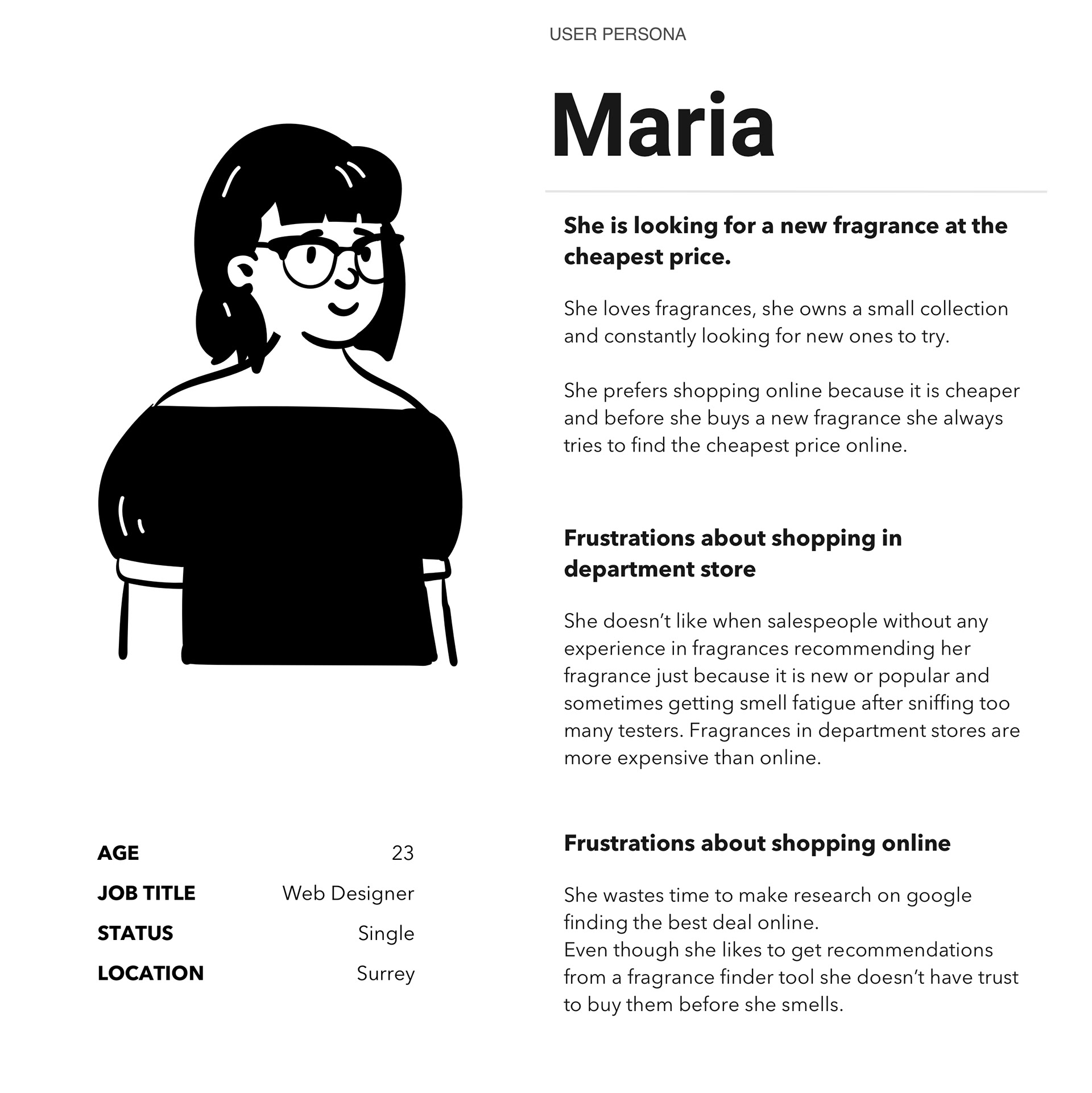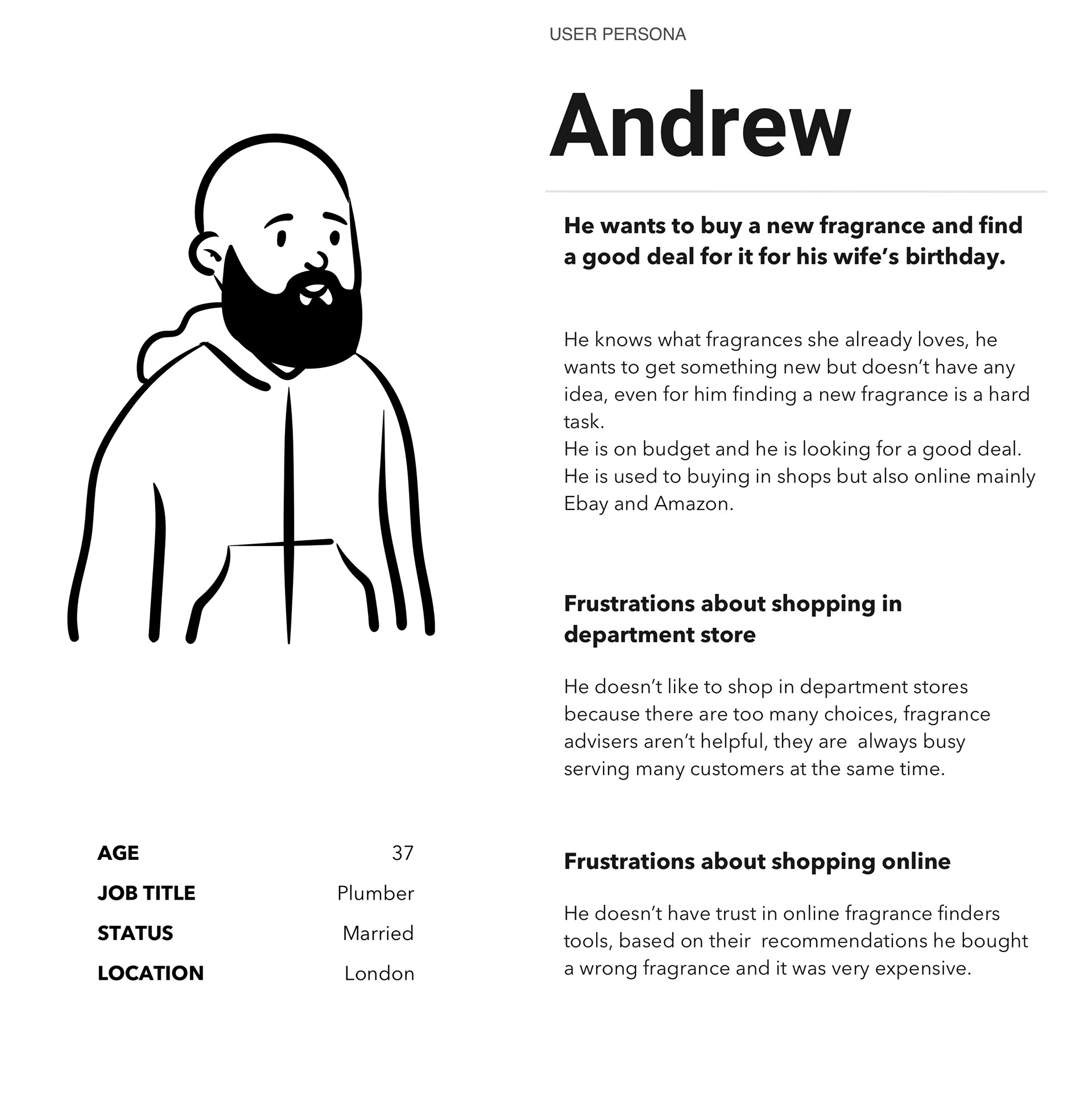PERFUME ADVISER - find the perfect fragrance at the lowest price.
DURATION: March 2020 - November 2020
TEAM/ROLE: Design team of one/ UX/UI Designer & UX Research & Design System
PROJECT INFO: Passion project case study
TOOLS: Sketch, Figma, Overflow
PLATFORM: iOS Mobile App
THE PROBLEM
Looking for a new fragrance?
We love fragrances! But it can be overwhelming when we are looking for a new fragrance either for ourselves or as a gift.
Several years ago as a fragrance lover living in a small town with few shops I became frustrated with the various fragrance finder tools I found online. I wanted to know more about the fragrances I liked, why I liked them, what the ingredients were, what other scents might I like and where I could find the best deals. All of this can be very time-consuming and confusing.
After I moved to London, still having a passion for fragrances I worked for two years as a fragrance adviser in a department store on one of the most visited streets in the world. During this period I had the privilege to observe, ask and listen to fragrance buyers worldwide.
Thinking there must be a comprehensive fragrance finder already built I researched the internet and App store but I found tools mostly asked you irrelevant questions and often gave wrong or expensive recommendations and no price comparison.
I realised the small-town problem I had years ago still persisted. Finding a new fragrance is difficult even if you do that in a department store or online.
Competitive Analysis
SOLUTION
I wanted to ask the question: "How do I make people feel safe and comfortable knowing that they can buy the perfect fragrance?"
Could I design a product for anyone who is looking for a new fragrance which is simple and friendly to use with a personal virtual adviser, helping you to find the perfect matches, at the lowest price online?
To start off, I thought of the typical fragrance buyers and created provisional personas to represent them. I based these personas on my experience working directly with fragrance buyers and referred to them throughout the project to help guide my design decisions and priorities.


High Level Flow, Notes and Wireframe Sketches
To figure out how people think about and see the value of a product and then how to build it - inspired by Donna Lichaw's book, The Users Journey - I created a concept story.
Concept story
This helped me unearth the problems that customers have and how they think, such as:
New fragrance buyers don’t like busy and unprofessional advisers because they give wrong recommendations.
With the question in my mind "How can I make the experience better?" my solution is to create a personal shopper experience where the customer can choose an adviser who will help and guide them through their entire journey. This way they will have all the attention they need.
New fragrance buyers don’t have trust in fragrance finders' tools because they give wrong recommendations.
I kept thinking "Why don't they trust?" and "What would I look for in a service that would make me trust it?" my solution is to improve the results of the fragrance, find the perfect match, be impartial to any brand and retailer and asking simple questions which are easy for everyone to understand and answer.
For example, if I tell you this scent smells like amber, it might not mean anything to you - we don’t know the vocabulary of scents. But we know colours are associated with emotions. So, I posed the question: ”Could the colours represent the smell?”. The answer is: ”Yes!” (according to The Colors of Care, Design & Emotion 2014, International Conference Colombia).
They conducted an online survey in order to investigate how consumers react to the names of olfactory families. They were only asked to freely associate olfactory family names with one or more colours. For this survey, they selected the most known families of fragrances in the market: citrus, floral, woody and oriental.
Survey Results
With the above research and from reading Giles Colborne's book Simple and Usable I created 4 colours: pink-floral olfactory group, green-citrus olfactory group, brown-woody olfactory group and red-oriental olfactory group. I tried with a simple question to identify which olfactory group the user prefers through the colours and I added labels for colours which might help from an accessibility point of view, as some users might have trouble distinguishing certain colours. By choosing the preferred olfactory group users to have an increased chance to find the right fragrance.
New fragrance buyers can’t make a decision because they have too many choices.
Why if you have too many choices, is difficult to make a decision? In the book Paradox of Choice -Why More is Less, psychologist Barry Schwartz argues that eliminating consumer choices can greatly reduce anxiety for shoppers. According to Schwartz what people regret most is the extra time spent analysing and comparing each and every bit of information, which can lead to frustration and fatigue, ultimately diminishing our decision-making ability.
My solution is to reduce stress and time for users to make the right decision. By displaying only three results which are the most appropriate to the user's preference it will be easier to choose and find the perfect fragrance.
New fragrance buyers want the best deal online.
The price comparison tool gives you the opportunity to choose the best deal on the market. The tool has the cheapest price right at the top and compares well-known retailers allowing customers to purchase not only the best deal but also to choose their preferred retailer.
How do I get users to click the buy button without knowing exactly what the fragrance will smell like?
Selling fragrances without smelling? Hmm.. sounds like an impossible task!
In one article from Forbes, in December 2018, Phlur, a new fragrance company stated that they sold perfume to 90,000 customers before they even smelled It.
"We learned that humans smell with our eyes first," said Phlur co-founder Eric Korman, who was previously head of Ralph Lauren's digital businesses.
With this quote in my mind and the fact that fragrances are memories (they should be described with something that evokes some kind of emotions), I discovered that stories cause readers to feel something, by telling the fragrance story, users become a part of that story, which can persuade them to buy it.
Showing the notes of the fragrance and the image of the bottle will also affect the user emotionally too.
How do I ensure users are coming back?
- 33% of customers who abandon business relationships do so because personalisation is lacking. (Accenture, 2018)
- 81% of consumers want brands to get to know them, and understand when to approach them. (Accenture, 2017)
- Retailers have less than eight seconds to engage a user on their website or app. (Microsoft, 2015)
Clearly, customers need a good reason to come back. To increase user engagement and retention rate personalisation would be important. By allowing users to create a profile we know more about them.
The Perfume Adviser gives you the opportunity to create a profile quickly and easily, by email or social media, and capture your preferred fragrances. You can do new configurations based on different characteristics and preferences.
Your virtual adviser will greet you by your name. It’s a traditional approach but still leaves a lasting impression.
Creating a profile is not mandatory, this could deter some users initially. Users are presented with a Join us / Log in screen right after onboarding but they can also continue as a guest. I tried to make this as clear as possible and give users the choices they need without pushing them through an account if they didn't yet want one.
Without being logged in users are prompted with a modal inviting them to register after they get their results, again without forcing users to join as they can dismiss the modal and proceed to results.
If they choose to create an account it is very important to be as clear as possible why they should they create one. Users can be reticent when they are asked for their details so it's better to inform them upfront of all the benefits of having an account.
How do I spread the word?
It's natural that we want to share our experiences with our friends, people trust recommendations coming from someone they know. With this in my mind, I created a share card.
Logged-in users are prompted with a modal inviting them to share their experience with a friend who is looking for a new fragrance.
To communicate the final product design I used the Overflow tool to create a user journey flow.
Perfume Adviser User Journey Flow
View the Perfume Adviser high-fidelity prototype
REFLECTION
Could Perfume Adviser survive during Covid if it was a real product?
During Covid restrictions, most of the fragrances shops were closed in the UK and even if it was a store open, like a duty-free one in the airport the testers were not allowed, you couldn't smell/try any fragrances. Yes, if Perfume Adviser was actually a real product it would have survived and 2020 had all the ingredients to make it a successful and innovative product.
The most challenging problem-solving.
Having in mind business and user needs I tried to come up with good solutions and one of the most challenging was: ”How do I get the users to click the buy button without knowing exactly what the fragrance will smell like?”
If what I had in my mind initially seemed impossible all started to make sense as I have been through all the steps and I am really proud of the outcome, and the solution I have managed to come up with.
If what I had in my mind initially seemed impossible all started to make sense as I have been through all the steps and I am really proud of the outcome, and the solution I have managed to come up with.
What would I do differently?
I could change the Registration Screen - should look the same as Log in Screen. After I finished the project I noticed that the Registration Screen has only the email address without giving users the opportunity to register with Apple or Google as I did on the Log-in Screen.
UI to be more interesting/engaging - maybe some animations.
KEY TAKEAWAYS
Put me in the user’s shoes.
I guess one of the most important things I have learned by working on this project is how far you can get only by putting yourself in the user's shoes. To deliver the right product I had to ask the right questions, and even though I have met real users initially - I couldn’t test what I have designed with real users. I would love to have the opportunity to test a prototype in the real world - so that is something to look up for.
Building a Design System.
As I am self-taught I started creating components more from curiosity rather than trying to be efficient. Learning to create a design system really made my work easier and more organised. I was so impressed with that and I dedicated a separate project in my portfolio to Design System.
